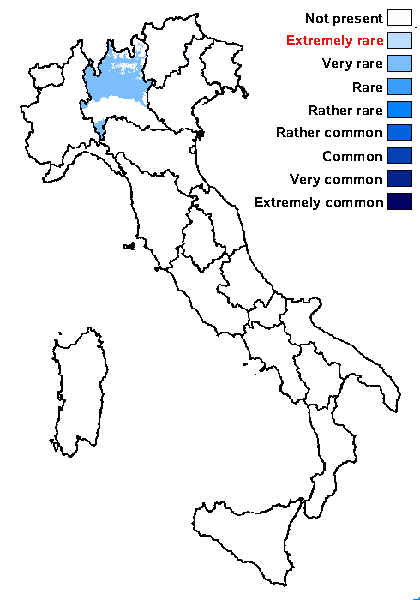Bagliettoa caesiella (Servít) ined.
provisionally placed here, ICN Art. 36.1b. Basionym: Verrucaria caesiella Servít - Stud. Bot. Cech., 9: 76, 1948.
Synonyms: Amphoridium caesiellum (Servít) Servít; Verrucaria caesiella (Servít) ined.; Verrucaria caesiella Servít; Verrucaria calciseda f. caesia Anzi
Distribution: N - Lomb (Gueidan & Roux 2007).
Description: Thallus crustose, partly endosubstratic, partly thinly episubstratic, grey-white to bluish white, continuous to faintly rimose-areolate near the perithecia, forming a crust which can be easily removed from the substrate. Upper cortex poorly differentiated, 25-40 μm thick; algal layer discontinuous, the algal cells arranged in vertical columns; medulla dense, filled with crystals, without oil cells (macrosphaeroids). Perithecia black, 0.25-0.3 mm high, 0.15-0.25 mm across, irregularly distributed and patchily crowded, immersed in the thallus, the apical part flattened. Involucrellum absent; exciple dark brown in upper part, pale to dark brown in lower part; hamathecium of periphyses and periphysoids, paraphyses dissolving early; periphyses abundant, branched and anastomosing, 30-65 x 2.54 μm; hymenial gel hemiamyloid, I+ red (I+ blue at very low concentrations of I), K/I+ blue. Asci 8-spored, two-layered, fissitunicate, with a thin tholus reacting I-, Verrucaria-type. Ascospores 1-celled, hyaline, ellipsoid 18-22(-24.5) x (8-)9-11(-12.5) μm. Photobiont chlorococcoid. Spot tests: K-, C-, KC-, P-, UV-. Chemistry: without lichen substances.
Note: A calcicolous species closely related to B. calciseda, differing in the smaller, densely arranged perithecia (to 0.3 mm in diam.), and the slightly smaller ascospores; rarely collected, and perhaps more widespread in the Alps. For a detailed description see Gueidan & Roux (2007).
Growth form: Crustose
Substrata: rocks
Photobiont: green algae other than Trentepohlia
Reproductive strategy: mainly sexual
Poorly known taxon in need of further study
Commonnes-rarity: (info)
Alpine belt: absent
Subalpine belt: extremely rare
Oromediterranean belt: absent
Montane belt: very rare
Submediterranean belt: very rare
Padanian area: absent
Humid submediterranean belt: absent
Humid mediterranean belt: absent
Dry mediterranean belt: absent

Predictive model
Growth form: Crustose
Substrata: rocks
Photobiont: green algae other than Trentepohlia
Reproductive strategy: mainly sexual
Poorly known taxon in need of further study
Commonnes-rarity: (info)
Alpine belt: absent
Subalpine belt: extremely rare
Oromediterranean belt: absent
Montane belt: very rare
Submediterranean belt: very rare
Padanian area: absent
Humid submediterranean belt: absent
Humid mediterranean belt: absent
Dry mediterranean belt: absent

Predictive model

